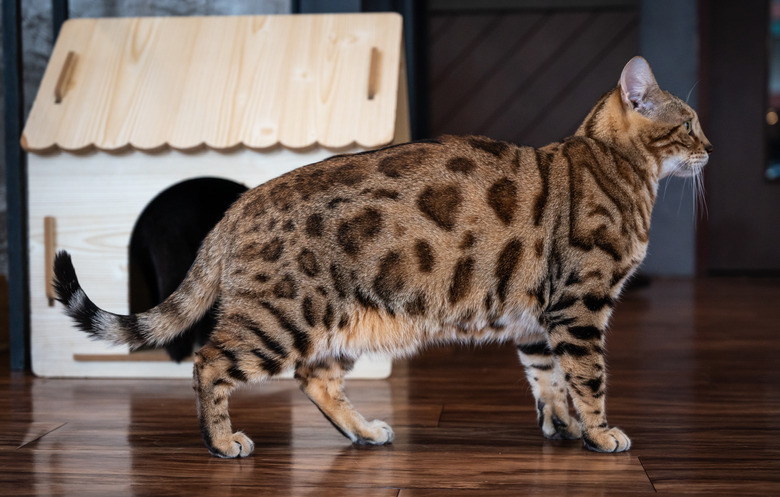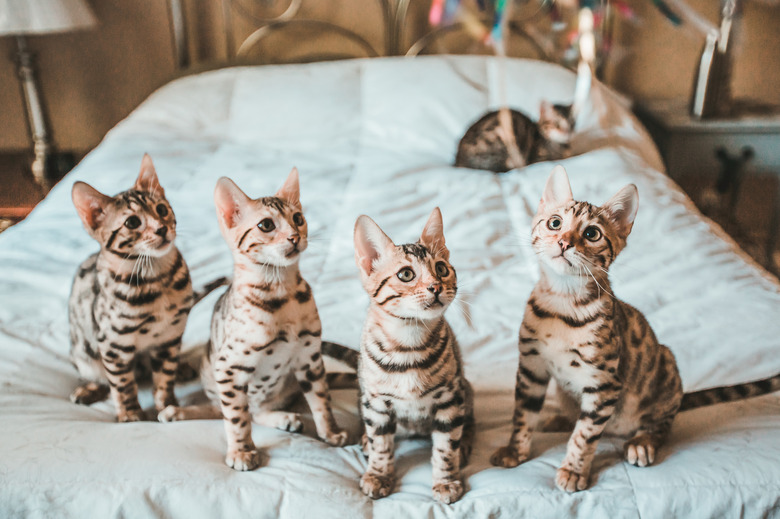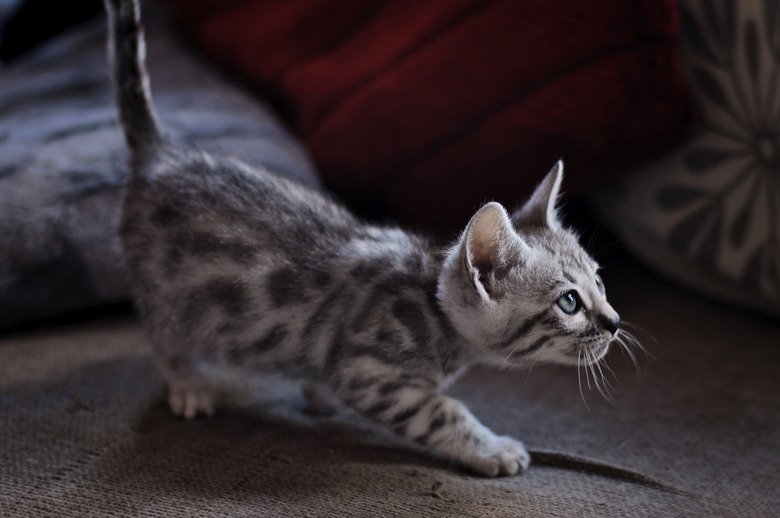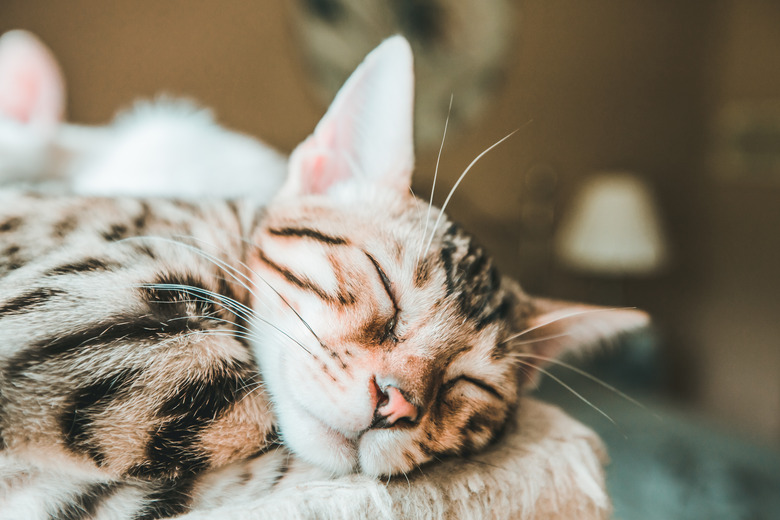Bengal Cat Breed Characteristics
Bengal quick facts
Bengal quick facts
Length: 16 – 22 inches
Weight: Females: 6 – 12 pounds, males: 9 – 15 pounds
Lifespan: 12 – 20 years
Coat length: short
Coloring: Brown tabby, charcoal marble, charcoal spotted, seal lynx point, seal mink tabby, seal sepia tabby, silver tabby spotted, and marble. Eye colors include green, yellow, and gold (lynx point cats have blue eyes)
Grooming needs: Low
Friendliness: Breed alone is not an accurate predictor of individual cats' personalities. However, Bengal cats are generally regarded as affectionate, playful, active, and intelligent.
The Bengal cat breed has become increasingly popular and is one of the International Cat Association's (TICA) most frequently shown breeds. They are medium to large cats that have a striking leopard-like appearance and affectionate and playful attitude. For those who like the idea of owning a wild cat, bringing a Bengal into your home is an opportunity to enjoy a domestic cat with the appearance of a wildcat. Make sure you are prepared to manage your Bengal's energy levels and care needs before selecting a new Bengal kitten.
Bengal cat history
Bengal cat history
Bengal cats are a fairly new domestic cat breed. They were created by the cat breeder Jean S. Mill in 1963 when she crossed a domestic house cat with a wild Asian leopard cat. The Asian leopard cat (Prionailurus bengalensis) is a small, wild cat that weighs about 5 to 12 pounds. Other cat breeders and conservationists also worked with creating hybrids with the Asian leopard cat including Willard Centerwall and Bill Engler. Though it was Mills' hybrid crosses that were used to create the domestic Bengal cat breed that is so popular today.
Bengals are no longer bred with wild cats and are a fully domestic breed. They have retained their wild appearance and muscular bodies. While they come in a variety of colors, you will commonly see brown spotted, rosetted, or marbled patterns on their coat.
Bengal cat personality
Bengal cat personality
Bengals are an extremely active breed, so cat owners should be prepared for plenty of play and running. Provide cat toys and a scratching post to help entertain the cat. They enjoy climbing to high places, so make sure to have cat trees and shelves set up.
Bengal cats do not enjoy being left alone. Consider pairing the Bengal with another cat or dog in the household, especially if you are out of the house for long hours. Despite their high energy, one of the Bengal's personality traits is affection. When they are sleepy and ready to rest, you may find your Bengal has turned into a lap cat.
The breed is also very intelligent and trainable. Many Bengals will play fetch with family members and you can train them to do tricks. Make sure to use positive reinforcement training methods. These cats tend to respond well to clicker training. You can even train a Bengal to walk on a leash.
Bengal cat lifespan and health issues
Bengal cat lifespan and health issues
The average lifespan for a Bengal ranges from 12 to 20 years. A healthy cat receiving regular veterinary care and a high-quality diet is likely to have increased longevity. There are some health conditions that are common to Bengal cats. Responsible breeders should test for these health problems and stop breeding any cats that are carriers of the diseases.
Hypertrophic cardiomyopathy is a common heart disease that causes the muscles of the heart to thicken which can prevent proper blood flow. Progressive retinal atrophy is an eye condition that eventually causes blindness and pyruvate kinase (PK) deficiency which can cause red blood cells to break down.
These cats may have digestion issues that can be misdiagnosed as intestinal bowel disease. In many cases, testing and treating any parasitic infections and ensuring the cat is on a high-quality diet can resolve the issue.
Bengal cat grooming and care
Bengal cat grooming and care
As shorthaired cats, Bengals have only minimal grooming to keep the spots and rosettes on their coat gleaming. Cats do shed their coats as winter transitions into spring, so an occasional brushing can help to remove loose hair. While no cat is truly hypoallergenic, the fact that Bengals rarely shed makes them a good option for cat lovers with allergies. The Cat Fanciers Association (CFA) only recognizes shorthaired Bengals, but the international association does recognize a longhaired Bengal breed. These cats need more frequent grooming to keep their coat free of mats and tangles.
Check your cat's nails at least once per month and trim them as needed. Dental care is also important. Chewing on a chew toy or chicken sticks can help your cat keep plaque from accumulating on their teeth.
Feed a high-quality commercial cat food that is high in protein as recommended by your veterinarian and make sure cats have constant access to fresh water. Bengals tend to love water and they may enjoy a filtered drinking fountain. Scoop out the litter box daily and change the litter regularly.
Welcoming a new cat into your home
Welcoming a new cat into your home
Bringing a Bengal cat or kitten into your home is an exciting event. Make sure you set up the home prior to the arrival of your new pet. Set up cat trees and litter boxes in various rooms, and in a quiet and accessible location. Remove any dangerous items such as poisonous houseplants and electrical cords. Further cat-proof the home by removing any breakable items from shelves and tables that a playing cat may knock over.
Give your new cat the space to explore their new environment on their own terms. Allow them to come to you and use positive reinforcement and redirection with toys to discourage unwanted behavior. It is a good idea to confine the cat to one room initially until they are comfortable before giving them free rein in the entire house.
If you have other pets in the home, introduce them to your new cat slowly so that they can build a positive relationship. Initially, allow them to smell each other through a door or baby gate. This can give you an idea of both animals' reactions and prevent fighting. With a bit of patience, these confident and curious cats typically adapt quickly to their new environment — and will soon be loyal members of the family.



